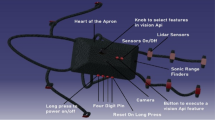Abstract
Background: According to the results of the second China Disability Sample Survey, there are about 12.33 million visually impaired people in China, and the number of visually impaired people is increasing year by year as China's society is aging. Therefore, it is becoming more and more urgent to solve their most basic travel problems. In the complex urban road environment, it becomes extremely difficult for visually impaired people to travel, not only by their own experience and sense of direction, but also by their efforts to identify various obstacles on the road through assistive devices. Traditional travel aids are mainly guide canes and guide dogs, but guide canes have many limitations for detecting obstacles, for example, obstacles above the chest are usually difficult to be detected, while guide dogs are very expensive to train and not suitable for general promotion. With the progress of sensors and computer technology, more and more intelligent products have entered the lives of visually impaired people, such as through wearable However, most of these products are not only expensive and very complicated to use, but also change the original habits of the blind and create a sense of resistance.
Aim: This paper focuses on exploring a travel assistance product that does not change the travel habits of visually impaired people and does not burden them psychologically, which not only provides timely feedback to visually impaired people about obstacles, but also protects their travel safety.
Methods: In this paper, we first analyzed the global smart travel products for visually impaired people, discussed the advantages and shortcomings of these products, and analyzed the living habits and behavioral characteristics of some visually impaired people by means of literature research and questionnaire survey, and based on the analysis results, we designed the smart mobility products, selected and installed suitable sensors, and programmed them. Finally, we tested the usability of the designed product in outdoor environment.
Conclusion: The test results show that the product design has certain usability and shortcomings, and further optimization is still needed in the future, but this design and research can provide reference advice for such smart product design.
Access this chapter
Tax calculation will be finalised at checkout
Purchases are for personal use only
Similar content being viewed by others
References
Yahui, W.: Packaging Design for Visually Impaired Nut-Based Snack Foods. Hunan University of Technology (2014)
Bao, T.: Comparison and analysis of the main data of the two national sample surveys on people with disabilities. Spec. Educ. China 86(8), 54–56 (2007)
Shiyun, L.: Wearable-based intelligent navigation design for the blind. Ind. Des. 000(3), 102–103 (2018)
Lianxin, L.: Introduction to Barrier-Free Design. China Construction Industry Press, Beijing (2004)
Xiaoyu, Z.: An analysis of the future realization of intelligent guide products. Consum. Electron. 12, 38–44 (2022)
Huiling, L.: Animal behavior applications - an introduction to the training and application of guide dogs for the blind. Lab. Anim. Sci. 27(4), 81–82 (2010)
Shiheng, W.: Research on the Guide Device Based on multi-Information Fusion Technology. Zhejiang University of Technology, Zhejiang (2013)
Wenqin, S.: Research on the Key Technology of Machine Vision-Based Outdoor Support System for the Blind. Zhejiang University, Zhejiang (2012)
Ulrich, I., Borenstein, J.: The guidecane-applying mobile robot technologies to assist the visually impaired people. IEEE Trans. Syst. 31(2), 131–136 (2001)
Zhuling, W.: User Experience-Based Design of Mobility Aids for the Blind: A Study of Blind People in Edinburgh UK. Shanghai Jiaotong University, Shanghai (2013)
Andrew, J.: Intelligent walkers for the elderly: performance and safety testing of VA-PAMAID robotic walker. Rehabilitation Research and Development Service, pp. 423–431 (2003)
Mori, H.: The matching fund project for practical use of robotic travel aid for the visually impaired. Adv. Robot. 453–472 (2004)
Aaron, M.: A RoboticWalker that provides guidance. In: Proceedings of International Conference on Robotics and Automation, pp. 25–30 (2003)
Xuewen, R.: A review of the current status of research on guide robots for the blind. Comput. Eng. Appl. 56(14), 1–13 (2020)
Zhongchao, W.: An intelligent voice guide based on ultrasonic distance measurement and PSD infrared distance measurement. Mod. Elec. Technol. 36(10), 115–118 (2013)
Ram, S.: The people sensor: a mobility aid for the visually impaired. In: Second International Symposium on Wearable Computers, pp. 166–167 (1998)
Filipe, V.: Blind navigation support system based on Microsoft Kinect. Proc. Comput. Sci. 94–101 (2012)
World Health Organization. International C1assification of Impairment, Disabilities and HandicapsWH.O Geneva (1980)
Li, C.: A study on the use of Braille in China. Lang. Writ. Appl. 2, 42–48 (2013)
Mascetti, S.: Sonification of guidance data during road crossing for people with visual impairments or blindness. Int. J. Hum. Comput. Stud. 85(C), 16–26 (2016)
Zhimin, L.: Barrier-Free Architectural Environment Design. Huazhong University of Science and Technology Press, Wuhan (2011)
Yinhong, L.: Universal controller for stepper motors with MSP430F149 microcontroller. Elec. Prod. World 22, 71–72 (2002)
Saba, F.: Blind’s eye: employing Google directions API for outdoor navigation of visually impaired pedestrians. Mehran Univ. Res. J. Eng. Technol. 36(3), 693–706 (2017)
Hongbin, M.: Design and implementation of a microcontroller-based intelligent cart obstacle avoidance system. Inf. Technol. 19(10), 76–78 (2018)
Qiang, F.: Application of Altium Designer software in circuit design. Sci. Technol. Commun. 14, 165–166 (2011)
Author information
Authors and Affiliations
Corresponding author
Editor information
Editors and Affiliations
Rights and permissions
Copyright information
© 2023 The Author(s), under exclusive license to Springer Nature Switzerland AG
About this paper
Cite this paper
Zhu, H., Zhou, M. (2023). Design and Research of Intelligent Walking Aid Products for Visually Impaired Individuals. In: Gao, Q., Zhou, J., Duffy, V.G., Antona, M., Stephanidis, C. (eds) HCI International 2023 – Late Breaking Papers. HCII 2023. Lecture Notes in Computer Science, vol 14055. Springer, Cham. https://doi.org/10.1007/978-3-031-48041-6_30
Download citation
DOI: https://doi.org/10.1007/978-3-031-48041-6_30
Published:
Publisher Name: Springer, Cham
Print ISBN: 978-3-031-48040-9
Online ISBN: 978-3-031-48041-6
eBook Packages: Computer ScienceComputer Science (R0)




